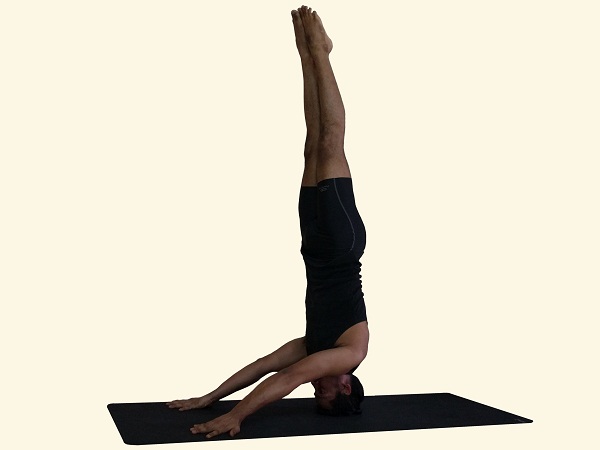Mukta means free and hasta means hand. It is quite similar to Mukta hasta sirshasana A, the difference being the palms facing down. This is one of the most difficult variation of headstand. It is comparitively easy to balance in this asana, but it is extremely difficult to go up and and come down keeping the legs straight. First try this near a wall till you get the confidence to do a free headstand. The benefits of all variations of headstand are almost the same.

Steps:
- Kneel down on a blanket or a mat.
- Bend forward and place the crown of the head on the mat.
- Stretch the arms straight out in front of the chest towards the feet and rest the palm on the floor. Keep the arms straight and palms down. The palm should be shoulder width apart.
- Lift your knee and straighten it, walk forward so that your trunk is perpendicular to the floor. Press the wrist against the floor, exhale and raise the feet. Tighten the legs and slowly raise them up until they are perpendicular.
- Stay in the pose with normal breathing for about 30 sec to 1 min
- Bring the legs down slowly trying to keep it straight and relax in Shashankasana.
Benefits:
- Strengthens and aligns the spine, neck, shoulders, and arms
- Tones the legs and abdominal muscles
- Helps to prevent water retention in the legs and feet
- Increases the flow of blood to the brain giving more oxygen to the cells
- Can help to treat chronic headaches, anxiety, asthma, sinusitis, hay fever, depression, diabetes, insomnia
- Reduces symptoms of menopause
- Increases mental awareness and clarity
- Calms and soothes the mind
- Helps to re-balance sleep patterns, while decreasing memory loss
- Stimulates and strengthens the lungs, promoting healthy breathing
- Improves digestion
- Stimulates pituitary and pineal glands, which aid growth and the production of sex hormones
- Aids in the relief of tonsillitis, persistent coughing, common cold, bad breath, and palpitations
- Helps overcome problems with the liver, kidneys, stomach, intestines, and reproductive organs by reversing the pull of gravity.
Contraindications:
- High blood pressure, heart disease, thrombosis, arteriosclerosis
- Severe neck problems, like spondylitis
- During headache or migraine,
- Chronic constipation
- Kidney failure
- During pregnancy and menstruation.
- Also due to increased pressure, it is not advised if you are severely near-sighted, if you have weak blood vessels in the eye, conjunctivitis, chronic glaucoma, inflammation of the ears or any form of hemorrhage in the head.
Look for other postures in our asana directory